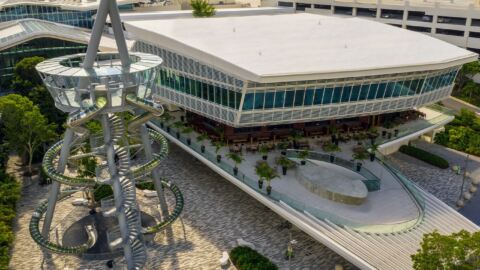Malls were once the nucleus of “shopping culture.” They were core destinations for all things retail; where families spent hours on a free Saturday and where teens, hungry for independence, spent many Friday nights to build their social clout.
But many shopping malls have endured an identity crisis. With the rise of ecommerce and the simultaneous “death of the mediocre middle,” many malls have become shells of their former selves — and some have become complete wastelands.
However, that doesn’t mean consumers don’t want to go to malls. In fact, more than 40% of adults reported visiting a mall within a two-week period in August, up from 35% at the beginning of June and 30% in the beginning of April, according to Coresight Research’s ongoing survey of 1,600 consumers. Coresight also found that traffic at top-tier malls was up 12% in 2022 over pre-pandemic 2019 levels, while traffic was up 10% at non-top-tier malls.
Consumers are increasingly eager to shop at malls, both enclosed and open-air, if the curation of brands and overall experience is right, according to Stephanie Cegielski, VP of Research for the International Council of Shopping Centers (ICSC). American Dream is one of the more recent, albeit extreme examples of this curation. The mall was designed to be a Xanadu of sorts, but the combination of retail, quality restaurants and food halls and high-end experiences is what makes it a lucrative destination for tenants. Many developers and landlords are taking note and applying similar levels of curation.
“Landlords are starting to get smart and almost recession-proofing themselves by including tenants that people are going to need, no matter what,” Cegielski said in an interview with Retail TouchPoints. “I have one [mall] by me that used to mainly be apparel retailers. Now there’s a YogaSix in there, a physical therapy place, because if you’re going to YogaSix, there’s a good chance I’m going to walk down to the Athleta and buy something after.”
To create a high-value experience that hits all consumer wants and needs, developers, landlords and tenants all need to:
- Understand the unique consumer needs and behaviors within the mall’s geographic area;
- Integrate the right combination of retail, services and experiences; and
- Enrich the omnichannel tech stack.
Designing Around the ‘Mall Community’
The core trend inspiring landlords and developers to rethink malls design and overall experience is the evolution in where and how people live. Looking at communities and environments through this anthropological lens can help ensure that spaces align with consumer needs and expectations.
“Start with people, think about the culture of how they live, and then you design the space,” said Phil Otto, Executive Design Director at architecture firm KTGY, who also is a trained cultural anthropologist. “Who is the end user? We’re all living in a digital world at the same time we’re in physical spaces, so how do you connect those spaces seamlessly? The rate of change is faster but what doesn’t change is human nature, so if you cater to the five senses, you can create some very dependable decision-making based on human nature.”
The key is to think beyond direct brand alignment within a shopping mall or center. For example, you don’t always have to place a Michaels next to a Lowe’s.
Advertisement
Landlords are a strong source of granular data about their properties’ local communities. “There’s a lot of cell phone data and other data that allows them to look at consumer behaviors inside and outside of the community,” Cegielski noted. “They know the demographics of that community and see where else and how else consumers behave.” Landlords will seek out tenants that best align with that data, and brands and retailers also can actively use community demographic data to validate their possible presence in a shopping mall.
The bottom line is that that landlords, or owners of retail real estate, need to shift their cultural makeup so they’re no longer “librarians” and more “editors,” according to Denz Ibrahim, Head of Retail and Futuring at LGIM Real Assets.
“Librarians were the age-old, quite static and inflexible owners that collected rent, rented shops and cleaned spaces,” Ibrahim explained. “That’s all a given. But now they need to shift culturally to be editors that are more content-focused and audience-focused.”
Cegielski pointed to Bridgewater Promenade in Bridgewater, N.J. as a powerful example of highly relevant retailer curation. Featuring retailers like Costco, Home Depot, Old Navy and Trader Joe’s, the 240,000-square-foot destination is vast — but tailored enough to meet the core needs of target consumers. “I’ll need to bring my car because the footprint is so big, but I can go and run half a dozen errands on my list in one location, so that saves me time,” she explained.
Enriching Retail with Restaurants and Experiences
Beyond core retail curation, landlords and developers need to master their mix of restaurant and entertainment options. Some of the more leading-edge destinations are venturing beyond traditional food court staples to create elevated food hall experiences and expand their restaurant mix. These more varied dining options could act as a strong magnet for foot traffic and inspire consumers to shop.
“There is clear value in dining [for shopping malls] and we saw it really accelerate pre-pandemic,” Cegielski said. “I was very concerned during the pandemic, but consumers always say they like to dine when they come to these destinations, and it’s more than a food court; it’s about having a choice of restaurants. It’s an experience where you can eat at a different restaurant every week.”
Malls also are aiming to expand their entertainment and experiential aspects. For example, Destiny USA in Syracuse, N.Y. touts more than 250 places to “shop, dine and play.” Among its “play” options is Dave & Buster’s, a suspended ropes course at WonderWorks and, if consumers are looking for a more tropical getaway experience, a Margaritaville location.
Dolphin Shopping Centre, also known as The Dolphin, in Dorset, England, also has completely reframed and redefined the goals of the traditional shopping mall. The space is an expansive redevelopment of the Kingland Cresent shopping district and includes a combination of High Street retail, local commerce and community-driven cultural experiences. It’s this rich, hybrid experience that makes it a valuable investment for big-name brands like H&M, Clarks and Claire’s as well as emerging brands like River Island.
To design The Dolphin, Ibrahim and his team devised a strategy called “Reframe, Remodel, Reposition.” The goal was to “reframe for minimum CapEx, maximum impact, and reframing the role of the asset in the town,” Ibrahim explained. “The goal was to go beyond just buying products on shelves and reframing the customer experience. Remodel is all about diversifying the mixed-use environment and the different type of occupiers, and diversifying revenue streams. And the last piece is reposition, which is all about driving long-term, future-fit environments by building out healthcare, education and residential.”
Creating Space for Emerging Brands and Community Moments
Innovative developers and landlords also are creating more space for local and emerging brands. While some mall owners historically were opposed to the “kiosk concept,” Cegielski noted that most are changing their tune, largely due to the foot traffic benefits that come with integrating new and emerging brands — especially those that have a loyal and passionate following online.
“Mall owners have found that bringing in some of those smaller, startup type brands to a temporary space or kiosk is beneficial on both sides,” Cegielski said. “The brand gets exposure, brand awareness and foot traffic, but then the mall benefits because that’s where you’ve discovered this brand, so you’re going to go back to the property and shop there again.”
Some destinations also are creating dedicated spaces to curate small businesses, artists and even activations, so that they better represent the culture of local communities. For example, The Dolphin has a modular layout with spaces dedicated to the needs of local artists, brands and even entrepreneurs:
- Gather is a space where creators, speakers and educators can host events;
- Kingland provides real estate for local businesses in a space adjacent to the main Dolphin mall;
- Street Market rents stalls for local brands that want to sell in a smaller space; and
- Foundry allows business owners and entrepreneurs to rent space for meetings, short-term offices and even boutiques.
In Q1 2023, consumer spend at The Dolphin was 7.8% ahead of the same period in 2022. Additionally, footfall for the first half of 2023 was up 10.6% over the first half of 2022 and is now ahead of 2019 levels. Critical to this experience’s success is a curation manager and cultivator, who is the “heart of the center,” according to Ibrahim.
“We hired that person to be heavily networked in the town; she understands the love it needs, she curates the market and the events, and she’s the glue of the entire experience,” Ibrahim explained. “You can’t copy and paste these experiences in different communities because then you fall into the same trap of 10 years ago, where it’s a cookie-cutter solution. What we’re really trying to do is create localized curation that is supporting the strategy and the finances but is also strongly embedded within the town itself.”
To create more opportunity for these emerging brands and local partners, landlords are using more flexible agreements, a dynamic shift that started with the evolution and heightened marketing value of pop-up shops.
“I’m noticing this less-tethered approach, because if you’re a retail brand, you want to be [at a mall] if it’s successful — but if it’s not going to produce for you, you want to be able to get out,” Otto said. “If you have a less-tethered approach with a smaller footprint, you can start with a pop-up and then hopefully it will lead to a more long-term experience. It keeps the space vital; the worst thing is when a space gets to that period of decline, and it just looks very vacant.”
Expanding the Mall Tech Stack
During the height of the pandemic, some mall owners implemented new omnichannel services and solutions to meet the immediate needs of consumers. For example, destinations like Galleria Dallas rolled out dedicated curbside pickup outposts to transform dormant malls into fulfillment centers. These investments have evolved and expanded as developers strove to create a more seamless experience for consumers and tenants alike; for example, Simon Properties has partnered with Dropit to bring omnichannel inventory management and fulfillment capabilities to its tenants.
Because consumers have grown accustomed to the streamlined nature of buying and picking up from one destination, “it’s smart for [developers] to figure out how to invest in the logistics, because a retail associate can’t leave the store to go find someone who’s parked outside of the mall,” Cegielski noted. “If the mall owner takes that out of the hands of the retailer, it’s beneficial for all parties. Being able to invest in that sort of infrastructure to solve those problems is a very wise investment.”
Others, like Easton, doubled down on building out their digital apps and experiences to adapt to the hybrid nature of modern shopping journeys. Simon Properties also recently implemented new AI-powered tools to facilitate holiday shopping. These digital platforms include basic information, such as center maps and directories, but they also are getting more granular to include robust services and digital touch points that make shopping in a large space more seamless and personalized.
















